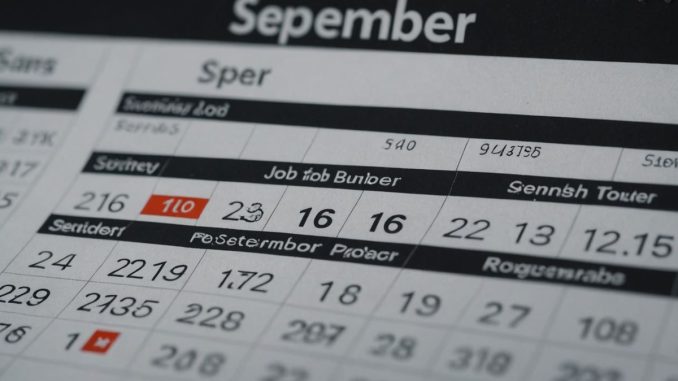
The July jobs report revealed a significant slowdown in hiring, with the unemployment rate reaching a three-year high. This has led experts to predict a steep interest rate cut by the Federal Reserve in September, with at least two more reductions likely before the end of the year.
Key Takeaways
- U.S. nonfarm payrolls increased by only 114,000 in July, far below the forecast of 175,000 jobs.
- The unemployment rate rose to 4.3%, triggering the Sahm Rule, a recession indicator.
- Futures traders now see an 80% probability of a half-point rate cut in September.
- Experts are divided on whether the economy is heading into a recession or just hitting a rough patch.
July Jobs Report: A Closer Look
The Bureau of Labor Statistics reported that U.S. nonfarm payrolls expanded by 114,000 in July, significantly below the economists’ forecast of 175,000 jobs. Over the past year, the U.S. economy had been creating an average of 215,000 jobs per month. Additionally, the June jobs report was revised downward by 27,000 jobs to 179,000.
The unemployment rate, derived from a separate survey, increased to 4.3% in July from 4.1% in June. This rise triggered the Sahm Rule, a recession indicator with a perfect track record over the past 50 years.
Market Reactions and Predictions
The weakening labor market has put pressure on the Federal Reserve’s rate-setting group, the Federal Open Market Committee (FOMC), to lower the short-term federal funds rate at their next meeting. Fed Chief Jerome Powell had already hinted at a possible rate cut in September during the central bank’s policy meeting on July 31.
As of August 2, futures traders assigned an 80% probability to the FOMC enacting a half-point cut in September, up from 22% a day earlier. Conversely, the odds of a quarter-point cut dropped to 20% from 78%.
Expert Opinions
Ian Shepherdson, Chairman and Chief Economist at Pantheon Macroeconomics:
"July’s poor employment report leaves the Fed looking woefully behind the curve with its decision to hold rates this week. The weakness was broad-based and unattributable to one-time factors, such as the weather."
Ryan Detrick, Chief Market Strategist at Carson Group:
"This is further proof that the economy is slowing, which has many worried the Fed is now firmly behind the eight ball. It is becoming clear that the Fed should be more worried about the economy than inflation."
Scott Helfstein, Head of Investment Strategy at Global X:
"While the jobs number surprised to the downside, it is not that bad. Since 2000, the average change in nonfarm payrolls is 94,000. This reading is still better than that at 114,000."
George Mateyo, Chief Investment Officer at Key Wealth:
"After two-plus years of better-than-expected job creation, the economy printed its first major downside surprise and unemployment rose more than anticipated. This marks an official ‘growth scare’ and one that the Fed will have to pay close attention to."
Eric Roberts, Executive Director and CEO at Fiera Capital U.S.:
"June’s softer report on consumer spending and inflation alone was not enough to guarantee a near-term rate cut, but this month’s report continues to build the case."
Scott Anderson, Chief U.S. Economist at BMO Capital Markets:
"The large miss in July nonfarm payrolls and jump in the unemployment rate underlines what we have been seeing in the overall U.S. economic data for some time now that aggregate demand is softening rapidly."
Sam Millette, Senior Investment Strategist at Commonwealth Financial Network:
"The July employment report showed serious cracks in the labor market, as headline hiring slowed notably during the month while the unemployment rate rose to an over two-year high."
Austin Schaul, Head of Research at Avantax:
"While today’s jobs report was weaker than expected, we hesitate to read too much into one number, and highlight the fact that GDP growth remains relatively strong."
David Royal, Chief Financial and Investment Officer at Thrivent:
"This report shows continued weakening in employment and the economy overall. The Fed was already likely to cut in September but this report, if confirmed by additional weak data, could cause some to consider the possibility of a 50 basis point cut at the next meeting."
Melissa Brown, Managing Director of Investment Decision Research at SimCorp:
"At first glance, the magnitude of the difference between the report of jobs added and consensus was a bit shocking. At the same time, the increase in unemployment was also bigger than expected, triggering renewed fear of recession."
Mike Sanders, Head of Fixed Income at Madison Investments:
"The yield curve is bull steepening, with the market now pricing in a 100% chance of a cut of at least 25 basis points in September."
Michael Conerly, Senior Fixed Income Portfolio Manager at Exencial Wealth Advisors:
"This report adds to the market’s conviction that the economy has been weakening and questions if Powell made a policy mistake on Wednesday."
Elyse Ausenbaugh, Head of Investment Strategy at J.P. Morgan Wealth Management:
"At this point, a September cut looks like a given – now the question is whether they go by 25 basis points or 50 basis points."
Steve Wyett, Chief Investment Strategist at BOK Financial:
"This morning’s labor report all but guarantees a rate cut at the next Fed meeting."
Ben Vaske, Senior Investment Strategist at Orion Portfolio Solutions:
"The question at this point is, however, will next month be a month too late for the first cut, or can this soft landing truly be engineered?"
David Russell, Vice President of Market Intelligence at TradeStation:
"These numbers reflect a sharp deceleration in hiring, confirming the weakness we saw in yesterday’s claims data."

